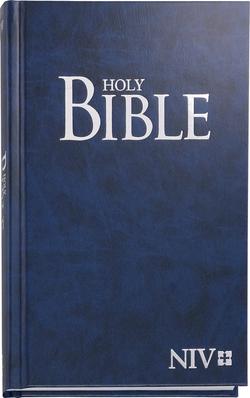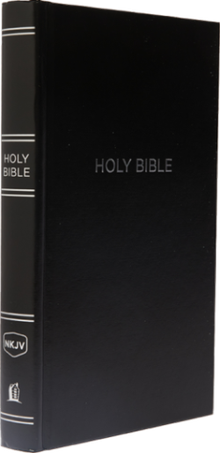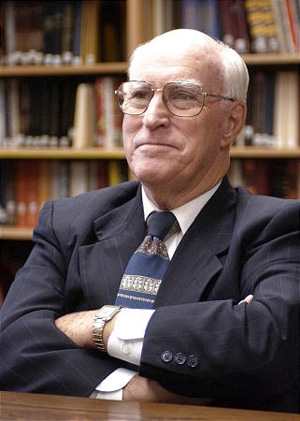
The Book of Mormon is a religious text of the Latter Day Saint movement, first published in 1830 by Joseph Smith as The Book of Mormon: An Account Written by the Hand of Mormon upon Plates Taken from the Plates of Nephi.

The Standard Works of the Church of Jesus Christ of Latter-day Saints are the four books that currently constitute its open scriptural canon. The four books of the standard works are:

The King James Version (KJV), also the King James Bible (KJB) and the Authorized Version (AV), is an Early Modern English translation of the Christian Bible for the Church of England, which was commissioned in 1604 and published in 1611, by sponsorship of King James VI and I. The 80 books of the King James Version include 39 books of the Old Testament, 14 books of Apocrypha, and the 27 books of the New Testament.

The New International Version (NIV) is a translation of the Bible into contemporary English. Published by Biblica, the complete NIV was released in 1978 with a minor revision in 1984 and a major revision in 2011. The NIV relies on recently-published critical editions of the original Hebrew, Aramaic, and Greek texts.

The Joseph Smith Translation (JST), also called the Inspired Version of the Holy Scriptures (IV), is a revision of the Bible by Joseph Smith, the founder of the Latter Day Saint movement, who said that the JST/IV was intended to restore what he described as "many important points touching the salvation of men, [that] had been taken from the Bible, or lost before it was compiled". Smith was killed before he deemed it complete, though most of his work on it was performed about a decade beforehand. The work is the King James Version of the Bible (KJV) with some significant additions and revisions. It is considered a sacred text and is part of the canon of Community of Christ (CoC), formerly the Reorganized Church of Jesus Christ of Latter Day Saints, and other Latter Day Saint churches. Selections from the Joseph Smith Translation are also included in the footnotes and the appendix of the Latter-day Saint edition of the LDS-published King James Version of the Bible. The Church of Jesus Christ of Latter-day Saints' edition of the Bible includes selections from the JST in its footnotes and appendix. It has officially canonized only certain excerpts that appear in the Pearl of Great Price. These excerpts are the Book of Moses and Smith's revision of part of the Gospel of Matthew.

The New King James Version (NKJV) is a translation of the Bible in contemporary English. Published by Thomas Nelson, the complete NKJV was released in 1982. With regard to its textual basis, the NKJV relies on a recently published critical edition for the Old Testament, while opting to use the Textus Receptus for the New Testament.

Modern English Bible translations consists of English Bible translations developed and published throughout the late modern period to the present.

Bruce Redd McConkie was a member of the Quorum of the Twelve Apostles of the Church of Jesus Christ of Latter-day Saints from 1972 until his death. McConkie was a member of the First Council of the Seventy of the LDS Church from 1946 until his calling to the Quorum of the Twelve Apostles.

The Reina–Valera is a Spanish translation of the Bible originally published in 1602 when Cipriano de Valera revised an earlier translation produced in 1569 by Casiodoro de Reina. This translation was known as the "Biblia del Oso" because the illustration on the title page showed a bear trying to reach a container of honeycombs hanging from a tree. Since that date, it has undergone various revisions, notably those of 1862, 1909, 1960, 1977, 1995, and 2011.

Avraham Gileadi is a Dutch-born American scholar and professor specializing in the Hebrew language and analysis of Book of Isaiah. A longtime professor at Brigham Young University, he was one of the "September Six" of prominent scholars excommunicated by the Church of Jesus Christ of Latter-day Saints in 1993, but several years later Gileadi was formally readmitted into the church and insists that his excommunication was recognized by church leadership as "a mistake".

Community of Christ and the Church of Jesus Christ of Latter-day Saints are two denominations that share a common heritage in the Church of Christ founded by Joseph Smith on April 6, 1830. Since Smith's death in 1844, they have evolved separately in belief and practices. The LDS Church is headquartered in Salt Lake City, Utah, and claims more than 17 million members worldwide; Community of Christ is headquartered in Independence, Missouri, and reports a worldwide membership of approximately 250,000.

Joseph Smith–Matthew is a book in the Pearl of Great Price, a scriptural text used by the Church of Jesus Christ of Latter-day Saints and other Latter Day Saint denominations. Joseph Smith–Matthew consists of Joseph Smith's "retranslation" of portions of the Gospel of Matthew. It was originally published in 1831 in Kirtland, Ohio, in an undated broadsheet as "Extract from the New Translation of the Bible".

In the Latter Day Saint movement, the great and abominable church is a church described in the Book of Mormon and other revelations by Joseph Smith. The great and abominable church is identified as being synonymous with the Whore of Babylon described in chapter 17 of the Book of Revelation. Although many Latter Day Saints have associated the great and abominable church with the Catholic Church, official publications of the Church of Jesus Christ of Latter-day Saints have discouraged this interpretation.
Bible Dictionary is an official publication of the Church of Jesus Christ of Latter-day Saints. Since 1979, Bible Dictionary has been published as an appendix to most copies of the King James Version (KJV) of the Bible printed by the LDS Church. The dictionary contains 1285 entries on 196 pages. The publication states that it was "designed to provide teachers and students with a concise collection of definitions and explanations of items that are mentioned in or are otherwise associated with the Bible."

Robert James Matthews was a Latter-day Saint religious educator and scholar, teaching in the departments of Ancient Scripture and Religious Education at Brigham Young University (BYU) in Provo, Utah.

John Thomas Fyans was a general authority of the Church of Jesus Christ of Latter-day Saints from 1974 until his death.

Sacred Name Bibles are Bible translations that consistently use Hebraic forms of the God of Israel's personal name, instead of its English language translation, in both the Old and New Testaments. Some Bible versions, such as the Jerusalem Bible, employ the name Yahweh, a transliteration of the Hebrew tetragrammaton (YHWH), in the English text of the Old Testament, where traditional English versions have LORD.

The standard works of Mormonism—the largest denomination of which is the Church of Jesus Christ of Latter-day Saints —have been the subject of various criticisms. Latter-day Saints believe the Book of Mormon is a sacred text with the same divine authority as the Bible; both are considered complementary to each other. Other Mormon sacred texts include the Pearl of Great Price and Doctrine and Covenants, which are also recognized as scripture. Religious and scholarly critics outside Mormonism have disputed Mormonism's unique scriptures, questioning the traditional narrative of how these books came to light and the extent to which they describe actual events. Critics cite research in history, archeology, and other disciplines to support their contentions.

Ellis Theo Rasmussen was an American professor and dean of Religious Instruction at Brigham Young University (BYU). He helped produce the edition of the Bible published by the Church of Jesus Christ of Latter-day Saints in 1979.
The Apostolic Bible Polyglot (ABP), originally published in 2003, is a Bible translation by Charles VanderPool. The ABP is an English translation with a Greek interlinear gloss and is keyed to a concordance. The numbering system, called "AB-Strong's", is a modified version of Strong's concordance, which was designed only to handle the traditional Hebrew Masoretic Text of the Old Testament, and the Greek text of the New Testament. Strong's concordance doesn't have numbering for the Greek O.T. The ABP utilizes a Greek Septuagint base for the O.T. and, therefore, required a modified system. The numbers and the Greek word appear immediately above the English translation instead of side by side, as is common in many interlinears.
















